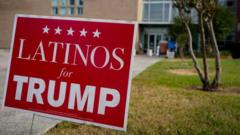With Trump's decisive victory over Kamala Harris, the election results illustrate a profound alteration in voter dynamics, particularly among Latino and working-class demographics. Traditionally a stalwart for Democrats, Latino voters appear to have shifted their allegiances in a notable way.
Trump managed to increase his support from Latino voters by a staggering 14 percentage points compared to the 2020 election, bolstered by strong performances in key battleground states such as Pennsylvania, Michigan, and Wisconsin. These states, collectively referred to as the "blue wall," now seem to favor Trump, who has assertively claimed victory in all three, challenging the Democratic stronghold previously established by Joe Biden.
In his victory address, Trump emphasized the unprecedented coalition that supported him, which he described as “the biggest, the broadest, the most unified coalition” in American history. This coalition included a diverse mix of constituents, from union members to various ethnic communities, including a growing Latino population in Pennsylvania.
Analysis of exit polls reveals that Trump garnered approximately 42% of the Latino vote in Pennsylvania, a remarkable rise from 27% in 2020. Observers within the Latino community pointed out that issues such as inflation were significant motivators. As Samuel Negron, a Puerto Rican state constable, noted, economic factors weigh heavily on voters’ minds, with many expressing their dissatisfaction with rising costs of living under Democratic leadership.
Moreover, the perception of immigration policies also played a pivotal role in this shifting demographic. Some Latino voters expressed concerns over border security, notably resonating with Trump's previous anti-immigration platform, which they view as necessary to enforce legal migration practices. Venezuelan-American Daniel Campo articulated this sentiment by drawing parallels with his home country's struggles with 'socialism,' thereby aligning with Trump's promise of stricter immigration control.
In Wisconsin, data indicated not just an increase in Trump support among Latino voters but also an uptick among younger men, with Biden’s margin of victory in the under-30 demographic shrinking significantly. The trends suggest a broader dissatisfaction with Harris’ outreach, as she failed to rally similar levels of support in suburban areas and failed to mobilize voters in Milwaukee, Wisconsin’s largest city.
Economic messaging resonated strongly across party lines, and Trump’s focus on inflation and cost of living issues is credited for improving his standing among blue-collar residents in Michigan as well. Many voters, like Nahim Uddin, voiced their concerns over skyrocketing interest rates and attributed their support to Trump’s perceived ability to restore affordable living.
While Democrats attempted to reposition their narratives around job growth in the electric vehicle sector, Trump’s counter-argument that such transitions could potentially jeopardize jobs resonated with many voters. The prevailing sentiment was that voters felt pragmatic about their financial realities, and many were prepared to hold Harris and Biden accountable for perceived economic mismanagement.
As the election results unfold, the implications of these shifts in Latino and working-class support reflect a changing political landscape in the United States that both parties will need to navigate moving forward.
Trump managed to increase his support from Latino voters by a staggering 14 percentage points compared to the 2020 election, bolstered by strong performances in key battleground states such as Pennsylvania, Michigan, and Wisconsin. These states, collectively referred to as the "blue wall," now seem to favor Trump, who has assertively claimed victory in all three, challenging the Democratic stronghold previously established by Joe Biden.
In his victory address, Trump emphasized the unprecedented coalition that supported him, which he described as “the biggest, the broadest, the most unified coalition” in American history. This coalition included a diverse mix of constituents, from union members to various ethnic communities, including a growing Latino population in Pennsylvania.
Analysis of exit polls reveals that Trump garnered approximately 42% of the Latino vote in Pennsylvania, a remarkable rise from 27% in 2020. Observers within the Latino community pointed out that issues such as inflation were significant motivators. As Samuel Negron, a Puerto Rican state constable, noted, economic factors weigh heavily on voters’ minds, with many expressing their dissatisfaction with rising costs of living under Democratic leadership.
Moreover, the perception of immigration policies also played a pivotal role in this shifting demographic. Some Latino voters expressed concerns over border security, notably resonating with Trump's previous anti-immigration platform, which they view as necessary to enforce legal migration practices. Venezuelan-American Daniel Campo articulated this sentiment by drawing parallels with his home country's struggles with 'socialism,' thereby aligning with Trump's promise of stricter immigration control.
In Wisconsin, data indicated not just an increase in Trump support among Latino voters but also an uptick among younger men, with Biden’s margin of victory in the under-30 demographic shrinking significantly. The trends suggest a broader dissatisfaction with Harris’ outreach, as she failed to rally similar levels of support in suburban areas and failed to mobilize voters in Milwaukee, Wisconsin’s largest city.
Economic messaging resonated strongly across party lines, and Trump’s focus on inflation and cost of living issues is credited for improving his standing among blue-collar residents in Michigan as well. Many voters, like Nahim Uddin, voiced their concerns over skyrocketing interest rates and attributed their support to Trump’s perceived ability to restore affordable living.
While Democrats attempted to reposition their narratives around job growth in the electric vehicle sector, Trump’s counter-argument that such transitions could potentially jeopardize jobs resonated with many voters. The prevailing sentiment was that voters felt pragmatic about their financial realities, and many were prepared to hold Harris and Biden accountable for perceived economic mismanagement.
As the election results unfold, the implications of these shifts in Latino and working-class support reflect a changing political landscape in the United States that both parties will need to navigate moving forward.



















